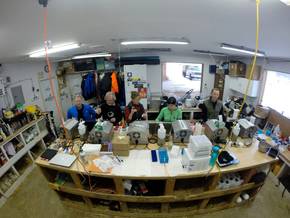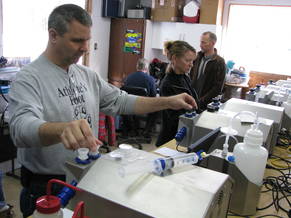Iditarod: Difference between revisions
No edit summary |
No edit summary |
||
| Line 2: | Line 2: | ||
<br /> | <br /> | ||
<br /> | <br /> | ||
<br /> | |||
== Racing dogs at Iditarod, Alaska 2014 == | == Racing dogs at Iditarod, Alaska 2014 == | ||
Revision as of 08:54, 18 May 2015
Racing dogs at Iditarod, Alaska 2014
Iditarod - The last great race(r) 2014: the greatest challenge up to the finish: » iditarod.com
At Martin Buser's 'Happy Trails Kennel' (Big Lake, near Anchorage, Alaska) Prof. Michael Davis (Comparative Exercise Physiology Laboratory, Oklahoma State University, USA) conducts a long-term collaboration with Martin's team to study and train the Alaskan dogs in preparation of long-distance races, the most challenging of which is the 1,100 mile Iditarod race. Martin Buser is 4 times champion of the Iditarod, with a scientifically oriented interest in the study of the genetics and physiology of the dogs that goes far beyond the race.
The line of mixed-breed Alaskan huskies of Martin incorporates sprint-dog lines and is selected and trained as much for long-distance endurance as for speed - and happiness. "Happy dogs perform better and make racing more fun" (Martin Buser).
In January and March 2014, Mike Davis and Katherine Williamson teamed up with Erich Gnaiger and Verena Laner (Medical University of Innsbruck and OROBOROS INSTRUMENTS), Robert Boushel (Swedish School of Sport and Health Sciences, Stockholm, SE), and Benjamin F. Miller and Karyn Hamilton (Colorado State University, US) to focus on mitochondrial respiratory function in the skeletal muscle of the dogs. With a Power-O2k approach using six OROBOROS O2k, these mitochondrial studies are conducted at the beginning of the intensive training period and after the Iditarod race, considered as the final stage of the most intensive endurance training.
» Mitochondrial pathways and respiratory control. An introduction to OXPHOS analysis.
The science team
The fast endurance heroes
The mitochondrial lab at Happy Trails Kennel
Dog skeletal muscle mitochondria: the first detailed study with SUIT protocols.
Getting connected
A visitor at Happy Trails Kennel
The mito team
- O2k-Network Lab: US OK Stillwater Davis MS
- O2k-Network Lab: SE Stockholm Boushel RC
- O2k-Network Lab: AT Innsbruck Gnaiger E
- Gnaiger Erich
- Laner Verena
Alaska Expedition post-study (March 2014)
Fotos by Gnaiger Erich and Laner Verena
Further links of interest
- Youtube
- k300: Congratulations to Rohn Buser for winning this race. "Rohn won it in 38 h and change, but not without a MAJOR challenge from Jeff King who made a run at Rohn in the last 5-10 miles, but couldn't overtake him. 300 miles (500 km) in 38 h. When you subtract the 10 h of mandatory rest, that means Rohn's dogs AVERAGED nearly 18 kph for over a day. These are the dogs we will investigate in March. That isn't even the race record. Ironically, the race record of 37 h 4 min is held by Martin Buser" (Michael S. Davis, 2014-01-20).




































